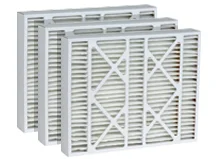Photo Credit: Alamy Stock Photo
By David Heacock
While lockdowns during the COVID-19 pandemic have brought about a host of issues, there have been several positive outcomes. In addition to limiting the spread of the virus, the lockdowns have resulted in better air quality due to decreased commercial activity and automobile traffic. However, the lifting of lockdowns and a recent surge of wildfires in Western and Mountain states may quickly reverse this trend, once again exposing millions of Americans to poor air quality.
According to data from the Environmental Protection Agency (EPA), prior to COVID-19, nearly one in four Americans resided in counties with poor air quality. While ozone-related pollutants are the most common cause of poor air quality, many Americans are also exposed to a variety of other common pollutants such as particle pollutants, sulfur dioxide, and lead.
While many Americans are still living in places with unhealthy levels of air pollution, conditions have been improving in recent decades. Through EPA efforts and the passage of the Clean Air Act, the U.S. has seen gradual improvement in air quality and a decline in the emissions of common pollutants since 1970. CO2 emissions have also shown small declines since 2010. Such improvements have occurred even with steady increases in the gross domestic product, travel, total population, and energy consumption.
Still, air quality in many areas, especially in the Western U.S., does not meet national standards. In addition to causing environmental issues, poor air quality can have negative consequences for individual health, which can be particularly detrimental to those already suffering from certain health problems such as asthma and cardiovascular disease. Additionally, new research indicates that economically disadvantaged communities are more likely to face higher levels of pollution. Furthermore, while the US has improved as a whole, the most polluted areas from 1980 are still among the most polluted today.
To identify metropolitan areas with the worst (and best) air quality, researchers from Filterbuy analyzed median Air Quality Index (AQI) values for 2019. These values, published annually by the EPA, are a measure of an area’s air pollution. Higher AQI values indicate that an area experiences higher pollution levels and lower air quality.
For the purpose of this report, only metropolitan areas with at least 500,000 residents were included. Here are the metropolitan areas with the worst (and best) air quality in the nation.
TRENDING
Replacing home air filters regularly can dramatically improve the air quality in your home. If you are dealing with particularly problematic conditions, consider using MERV 13 air filters.
Metros with the Worst Air Quality
 Photo Credit: Alamy Stock Photo
Photo Credit: Alamy Stock PhotoRiverside-San Bernardino-Ontario, CA
- Median Air Quality Index for 2019: 89
- Good days: 42
- Moderate days: 178
- Unhealthy or hazardous days: 145
- Maximum Air Quality Index observed in 2019: 213
- Population: 4,622,361
 Photo Credit: Alamy Stock Photo
Photo Credit: Alamy Stock PhotoPhoenix-Mesa-Scottsdale, AZ
- Median Air Quality Index for 2019: 74
- Good days: 50
- Moderate days: 261
- Unhealthy or hazardous days: 54
- Maximum Air Quality Index observed in 2019: 886
- Population: 4,857,962
 Photo Credit: Alamy Stock Photo
Photo Credit: Alamy Stock PhotoLos Angeles-Long Beach-Anaheim, CA
- Median Air Quality Index for 2019: 72
- Good days: 66
- Moderate days: 208
- Unhealthy or hazardous days: 91
- Maximum Air Quality Index observed in 2019: 201
- Population: 13,291,486
 Photo Credit: Alamy Stock Photo
Photo Credit: Alamy Stock PhotoBakersfield, CA
- Median Air Quality Index for 2019: 67
- Good days: 119
- Moderate days: 151
- Unhealthy or hazardous days: 95
- Maximum Air Quality Index observed in 2019: 548
- Population: 896,764
 Photo Credit: Alamy Stock Photo
Photo Credit: Alamy Stock PhotoSan Diego-Carlsbad, CA
- Median Air Quality Index for 2019: 64
- Good days: 87
- Moderate days: 253
- Unhealthy or hazardous days: 25
- Maximum Air Quality Index observed in 2019: 169
- Population: 3,343,364
 Photo Credit: Alamy Stock Photo
Photo Credit: Alamy Stock PhotoFresno, CA
- Median Air Quality Index for 2019: 60
- Good days: 139
- Moderate days: 160
- Unhealthy or hazardous days: 66
- Maximum Air Quality Index observed in 2019: 187
- Population: 994,400
 Photo Credit: Alamy Stock Photo
Photo Credit: Alamy Stock PhotoDenver-Aurora-Lakewood, CO
- Median Air Quality Index for 2019: 58
- Good days: 91
- Moderate days: 252
- Unhealthy or hazardous days: 22
- Maximum Air Quality Index observed in 2019: 154
- Population: 2,932,415
 Photo Credit: Alamy Stock Photo
Photo Credit: Alamy Stock PhotoPittsburgh, PA
- Median Air Quality Index for 2019: 56
- Good days: 129
- Moderate days: 220
- Unhealthy or hazardous days: 16
- Maximum Air Quality Index observed in 2019: 161
- Population: 2,324,743
 Photo Credit: Alamy Stock Photo
Photo Credit: Alamy Stock PhotoDetroit-Warren-Dearborn, MI
- Median Air Quality Index for 2019: 56
- Good days: 135
- Moderate days: 217
- Unhealthy or hazardous days: 13
- Maximum Air Quality Index observed in 2019: 142
- Population: 4,326,442
 Photo Credit: Alamy Stock Photo
Photo Credit: Alamy Stock PhotoChicago-Naperville-Elgin, IL-IN-WI
- Median Air Quality Index for 2019: 55
- Good days: 121
- Moderate days: 227
- Unhealthy or hazardous days: 17
- Maximum Air Quality Index observed in 2019: 174
- Population: 9,498,716
Metros with the Best Air Quality
Methodology & Detailed Findings
The data used in this analysis is from the EPA’s 2019 Air Quality Index Report. The Air Quality Index (AQI) is EPA’s method for reporting daily air quality by location based on National Ambient Air Quality Standards. Higher AQI values correspond to higher levels of pollution and worse air quality. AQI values below 50 are considered good; AQI values between 51 and 100 are considered moderate; and AQI values that exceed 100 are considered unhealthy (at first for sensitive groups and then for everyone as values increase).
To determine the locations with the worst air quality, metropolitan areas were ranked by their respective median AQI values, with high AQI values corresponding to worse air quality. In the event of a tie, the location with the higher maximum AQI value was considered to have worse air quality.
Population data is from the U.S. Census Bureau’s 2018 American Community Survey 1-Year Estimates. Only metropolitan areas with at least 500,000 residents were included in the report.
 Photo Credit: Alamy Stock Photo
Photo Credit: Alamy Stock PhotoUrban Honolulu, HI
- Median Air Quality Index for 2019: 29
- Good days: 339
- Moderate days: 26
- Unhealthy or hazardous days: 0
- Maximum Air Quality Index observed in 2019: 94
- Population: 980,080
 Photo Credit: Alamy Stock Photo
Photo Credit: Alamy Stock PhotoLakeland-Winter Haven, FL
- Median Air Quality Index for 2019: 36
- Good days: 314
- Moderate days: 51
- Unhealthy or hazardous days: 0
- Maximum Air Quality Index observed in 2019: 100
- Population: 708,009
 Photo Credit: Alamy Stock Photo
Photo Credit: Alamy Stock PhotoCape Coral-Fort Myers, FL
- Median Air Quality Index for 2019: 36
- Good days: 328
- Moderate days: 36
- Unhealthy or hazardous days: 1
- Maximum Air Quality Index observed in 2019: 108
- Population: 754,610
 Photo Credit: Alamy Stock Photo
Photo Credit: Alamy Stock PhotoSyracuse, NY
- Median Air Quality Index for 2019: 37
- Good days: 337
- Moderate days: 28
- Unhealthy or hazardous days: 0
- Maximum Air Quality Index observed in 2019: 77
- Population: 650,502
 Photo Credit: Alamy Stock Photo
Photo Credit: Alamy Stock PhotoRochester, NY
- Median Air Quality Index for 2019: 37
- Good days: 317
- Moderate days: 48
- Unhealthy or hazardous days: 0
- Maximum Air Quality Index observed in 2019: 90
- Population: 1,071,082
 Photo Credit: Alamy Stock Photo
Photo Credit: Alamy Stock PhotoAlbany-Schenectady-Troy, NY
- Median Air Quality Index for 2019: 37
- Good days: 322
- Moderate days: 43
- Unhealthy or hazardous days: 0
- Maximum Air Quality Index observed in 2019: 92
- Population: 883,169
 Photo Credit: Alamy Stock Photo
Photo Credit: Alamy Stock PhotoScranton--Wilkes-Barre--Hazleton, PA
- Median Air Quality Index for 2019: 38
- Good days: 329
- Moderate days: 36
- Unhealthy or hazardous days: 0
- Maximum Air Quality Index observed in 2019: 85
- Population: 555,485
 Photo Credit: Alamy Stock Photo
Photo Credit: Alamy Stock PhotoGrand Rapids-Wyoming, MI
- Median Air Quality Index for 2019: 38
- Good days: 298
- Moderate days: 67
- Unhealthy or hazardous days: 0
- Maximum Air Quality Index observed in 2019: 100
- Population: 1,069,405
 Photo Credit: Alamy Stock Photo
Photo Credit: Alamy Stock PhotoPortland-Vancouver-Hillsboro, OR-WA
- Median Air Quality Index for 2019: 38
- Good days: 285
- Moderate days: 77
- Unhealthy or hazardous days: 3
- Maximum Air Quality Index observed in 2019: 128
- Population: 2,478,810
 Photo Credit: Alamy Stock Photo
Photo Credit: Alamy Stock PhotoMadison, WI
- Median Air Quality Index for 2019: 39
- Good days: 285
- Moderate days: 80
- Unhealthy or hazardous days: 0
- Maximum Air Quality Index observed in 2019: 93
- Population: 660,422

.webp)
.webp)
.webp)
.webp)







